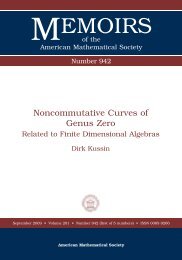University of Paderborn Department of Mathematics Diploma Thesis ...
University of Paderborn Department of Mathematics Diploma Thesis ...
University of Paderborn Department of Mathematics Diploma Thesis ...
Create successful ePaper yourself
Turn your PDF publications into a flip-book with our unique Google optimized e-Paper software.
3.3. STABLE IDEALS WITH THE SAME DOUBLE SATURATION 69Algorithm 3.39. (Computation <strong>of</strong> all Hilbert series to a given Hilbert polynomial) Letp(z) be the Hilbert polynomial <strong>of</strong> R/I for I ⊂ R a saturated homogeneous ideal.Input. A Hilbert polynomial p(z).1. Compute the unique lexicographic ideal L p <strong>of</strong> Theorem 2.25 from p(z).2. Use pairs <strong>of</strong> contractions and expansions to compute all saturated lexicographic idealsL H <strong>of</strong> Theorem 2.21 with p R/LH (z) = p(z).3. Use the formula <strong>of</strong> Theorem 2.17 to compute the Hilbert series <strong>of</strong> any such lexicographicideal L H .Output. All Hilbert series H R/J (t) for some saturated homogeneous ideal J ⊂ R withp(z) = p R/J (z).Pro<strong>of</strong>. (Correctness) The algorithm works correct by Theorem 2.25, Corollary 3.37 andTheorem 2.17.Step 2 <strong>of</strong> the algorithm does not specify any details <strong>of</strong> how to use the pairs <strong>of</strong> contractionsand expansion to find all lexicographic ideals L H in a systematic way – this will becomeclear, when we present the source code to this step within Chapter 4.Another consequence <strong>of</strong> Corollary 3.37 and Theorem 3.35 gives us a characterization <strong>of</strong> theunique lexicographic ideal L p associated to a Hilbert polynomial p(z), which we introducedin Theorem 2.25:Corollary 3.40. Let p(z) ≠ 0 be the Hilbert polynomial <strong>of</strong> R/I for some saturated stableideal I ⊂ R.(i) Among all saturated lexicographic ideals L H associated to Hilbert series H(t), suchthat p(z) = p R/LH (z), there is exactly one saturated lexicographic ideal with onlyone minimal generator containing the last variable x n−1 . This ideal is the uniquelexicographic ideal L p associated to the Hilbert polynomial p(z) by Theorem 2.25.(ii) The Hilbert function <strong>of</strong> R/L p is minimal among all Hilbert functions h R/J associatedto the Hilbert polynomial p(z), where J ⊂ R is a saturated homogeneous ideal.In particular: For any saturated lexicographic ideal L H associated to a Hilbert seriesH(t), such that p(z) = p R/LH (z), we have h R/Lp (i) ≤ h R/LH (i) for all i ∈ N 0 .Pro<strong>of</strong>. The first assertion follows from Corollary 3.37 and the pro<strong>of</strong> <strong>of</strong> Theorem 3.35. Thesecond one follows from the fact that we can compute any such lexicographic ideal L H fromL p by a sequence <strong>of</strong> paired contractions and expansions: When we proved Proposition 3.23and Corollary 3.26, we characterized the effect <strong>of</strong> such expansions and contractions onthe values <strong>of</strong> the Hilbert function. Let m denote the last monomial generator <strong>of</strong> L p andmd := deg m. The contraction <strong>of</strong> in L p provides h L con(i) = hp Lp (i) + 1 for all i ≥ d − 1.x n−1
















